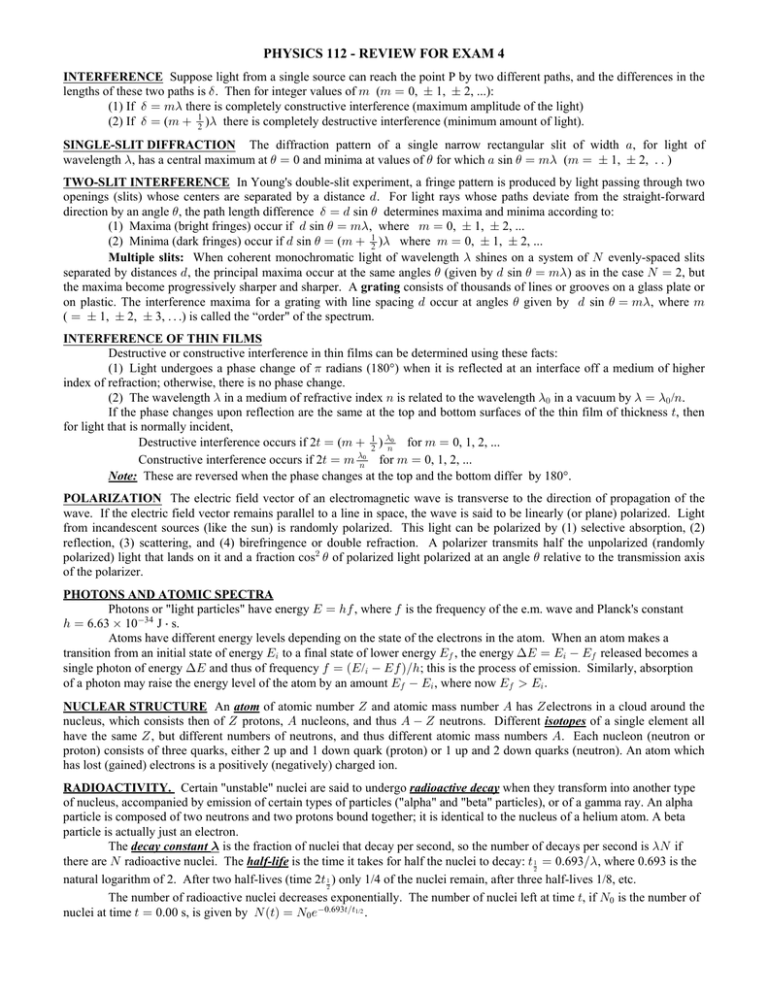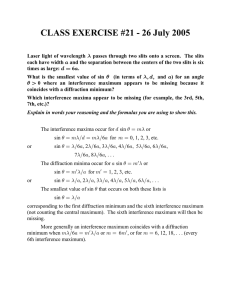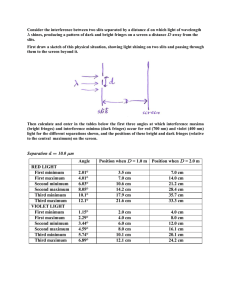PHYSICS 112 - REVIEW FOR EXAM 4
advertisement

PHYSICS 112 - REVIEW FOR EXAM 4 INTERFERENCE Suppose light from a single source can reach the point P by two different paths, and the differences in the lengths of these two paths is $ . Then for integer values of 7 (7 œ 0, „ 1, „ 2, ...): (1) If $ œ 7- there is completely constructive interference (maximum amplitude of the light) (2) If $ œ (7 12 )- there is completely destructive interference (minimum amount of light). SINGLE-SLIT DIFFRACTION The diffraction pattern of a single narrow rectangular slit of width +, for light of wavelength -, has a central maximum at ) œ 0 and minima at values of ) for which + sin ) œ 7- (7 œ „ 1, „ 2, . . ) TWO-SLIT INTERFERENCE In Young's double-slit experiment, a fringe pattern is produced by light passing through two openings (slits) whose centers are separated by a distance . . For light rays whose paths deviate from the straight-forward direction by an angle ) , the path length difference $ œ . sin ) determines maxima and minima according to: (1) Maxima (bright fringes) occur if . sin ) œ 7-, where 7 œ 0, „ 1, „ 2, ... (2) Minima (dark fringes) occur if . sin ) œ (7 12 )- where 7 œ 0, „ 1, „ 2, ... Multiple slits: When coherent monochromatic light of wavelength - shines on a system of R evenly-spaced slits separated by distances . , the principal maxima occur at the same angles ) (given by . sin ) œ 7-) as in the case R œ 2, but the maxima become progressively sharper and sharper. A grating consists of thousands of lines or grooves on a glass plate or on plastic. The interference maxima for a grating with line spacing . occur at angles ) given by . sin ) œ 7-, where 7 ( œ „ 1, „ 2, „ 3, . . .) is called the “order" of the spectrum. INTERFERENCE OF THIN FILMS Destructive or constructive interference in thin films can be determined using these facts: (1) Light undergoes a phase change of 1 radians (180°) when it is reflected at an interface off a medium of higher index of refraction; otherwise, there is no phase change. (2) The wavelength - in a medium of refractive index 8 is related to the wavelength -! in a vacuum by - œ -! /8. If the phase changes upon reflection are the same at the top and bottom surfaces of the thin film of thickness >, then for light that is normally incident, Destructive interference occurs if 2> œ (7 12 ) -80 for 7 œ 0, 1, 2, ... Constructive interference occurs if 2> œ 7 -80 for 7 œ 0, 1, 2, ... Note: These are reversed when the phase changes at the top and the bottom differ by 180°. POLARIZATION The electric field vector of an electromagnetic wave is transverse to the direction of propagation of the wave. If the electric field vector remains parallel to a line in space, the wave is said to be linearly (or plane) polarized. Light from incandescent sources (like the sun) is randomly polarized. This light can be polarized by (1) selective absorption, (2) reflection, (3) scattering, and (4) birefringence or double refraction. A polarizer transmits half the unpolarized (randomly polarized) light that lands on it and a fraction cos# ) of polarized light polarized at an angle ) relative to the transmission axis of the polarizer. PHOTONS AND ATOMIC SPECTRA Photons or "light particles" have energy I œ 20 , where 0 is the frequency of the e.m. wave and Planck's constant 2 œ 6.63 ‚ 1034 J † s. Atoms have different energy levels depending on the state of the electrons in the atom. When an atom makes a transition from an initial state of energy I3 to a final state of lower energy I0 , the energy ?I œ I3 I0 released becomes a single photon of energy ?I and thus of frequency 0 œ ÐI /3 I0 ÑÎ2; this is the process of emission. Similarly, absorption of a photon may raise the energy level of the atom by an amount I0 I3 , where now I0 I3 Þ NUCLEAR STRUCTURE An atom of atomic number ^ and atomic mass number E has ^ electrons in a cloud around the nucleus, which consists then of ^ protons, E nucleons, and thus E ^ neutrons. Different isotopes of a single element all have the same ^ , but different numbers of neutrons, and thus different atomic mass numbers E. Each nucleon (neutron or proton) consists of three quarks, either 2 up and 1 down quark (proton) or 1 up and 2 down quarks (neutron). An atom which has lost (gained) electrons is a positively (negatively) charged ion. RADIOACTIVITY. Certain "unstable" nuclei are said to undergo radioactive decay when they transform into another type of nucleus, accompanied by emission of certain types of particles ("alpha" and "beta" particles), or of a gamma ray. An alpha particle is composed of two neutrons and two protons bound together; it is identical to the nucleus of a helium atom. A beta particle is actually just an electron. The decay constant - is the fraction of nuclei that decay per second, so the number of decays per second is -R if there are R radioactive nuclei. The half-life is the time it takes for half the nuclei to decay: > "# œ 0.693Î-, where 0.693 is the natural logarithm of 2. After two half-lives (time 2> "# ) only 1/4 of the nuclei remain, after three half-lives 1/8, etc. The number of radioactive nuclei decreases exponentially. The number of nuclei left at time >, if R0 is the number of nuclei at time > œ 0.00 s, is given by R Ð>Ñ œ R0 /0.693>Î>1/2 .
![Wave Interference []](http://s3.studylib.net/store/data/009269968_1-97379e48baef1370e4514f73f8b3c35d-300x300.png)




